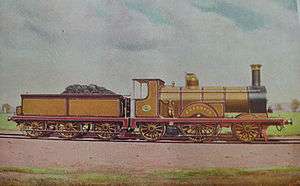LB&SCR G class
The LB&SCR G class were powerful 2-2-2 locomotives, designed by William Stroudley of the London Brighton and South Coast Railway in 1874.
| London Brighton and South Coast Railway Class G | |||||||||||||||||||||||||||||||||
|---|---|---|---|---|---|---|---|---|---|---|---|---|---|---|---|---|---|---|---|---|---|---|---|---|---|---|---|---|---|---|---|---|---|
 Stroudley 'G' class single | |||||||||||||||||||||||||||||||||
| |||||||||||||||||||||||||||||||||
| |||||||||||||||||||||||||||||||||
| |||||||||||||||||||||||||||||||||
History
A prototype single locomotive, No. 151 Grosvenor, was designed by Stroudley and produced by Brighton railway works in December 1874. This was extensively tested before a second, scaled down locomotive No. 325 Abergavenny, was ordered in June 1876 and completed in January 1877. Both locomotives performed adequately, but Abergavenny was significantly less powerful than Grosvenor. A modified design was developed and twelve further locomotives were built between December 1880 and November 1881. The members of this class worked express trains between London and South Coast towns such as Portsmouth, Brighton and Eastbourne, and covered large mileages. The introduction of the Billinton B2 class made the singles redundant on the Portsmouth line and so several were transferred to Tunbridge Wells.
Withdrawals began in May 1905 and the last locomotive survived until May 1914. No examples have been preserved, but there is a model of No.331 Fairlight in the museum at Sheffield Park on the Bluebell Railway.
Locomotive summary
| LBSC No. | Date Built | New No. | Date | Name | Withdrawn |
|---|---|---|---|---|---|
| 151 | December 1874 | 326 | December 1880 | Grosvenor | May 1907 |
| 325 | January 1877 | Abergavenny | June 1909 | ||
| 327 | December 1880 | Imberhorne | April 1910 | ||
| 328 | February 1881 | Sutherland | April 1908 | ||
| 329 | May 1881 | 329A | December 1909 | Stephenson | May 1914 |
| 330 | June 1881 | Newhaven | November 1908 | ||
| 331 | July 1881 | Fairlight | February 1909 | ||
| 332 | July 1881 | Shanklin | March 1910 | ||
| 333 | August 1881 | Ventnor | November 1908 | ||
| 334 | July 1881 | Petworth | November 1908 | ||
| 335 | October 1881 | Connaught | May 1907 | ||
| 336 | October 1881 | Edinburgh | May 1907 | ||
| 337 | October 1881 | Yarmouth | June 1908 | ||
| 338 | November 1881 | Bembridge | July 1908 | ||
| 339 | December 1881 | London | November 1908 | ||
| 340 | December 1881 | Medina | November 1908 | ||
| 341 | January 1882 | Parkhurst | June 1907 | ||
| 342 | January 1882 | St Lawrence | January 1911 | ||
| 343 | January 1882 | Wilmington | June 1907 | ||
| 344 | January 1882 | Hurstmonceux | November 1908 | ||
| 345 | March 1882 | Plumpton | January 1911 | ||
| 346 | April 1882 | Alfriston | November 1908 | ||
| 347 | April 1882 | Dallington | June 1908 | ||
| 348 | April 1882 | Lullington | July 1908 | ||
| 349 | May 1882 | Albany | March 1910 | ||
| 350 | May 1882 | Southbourne | July 1908 | ||
Sources
- Bradley, D.L. (1969). The locomotives of the London, Brighton & South Coast Railway: Part 1. The Railway Correspondence and Travel Society.
- Ahrons, E.L. (1927). The British Steam Railway Locomotive from 1825 to 1925. London Locomotive Publishing Co. Ltd. p. 187.
External links
- Stroudley "G" Class Single 2-2-2 Southern E-Group
- LB&SC steam locomotives The Terminal